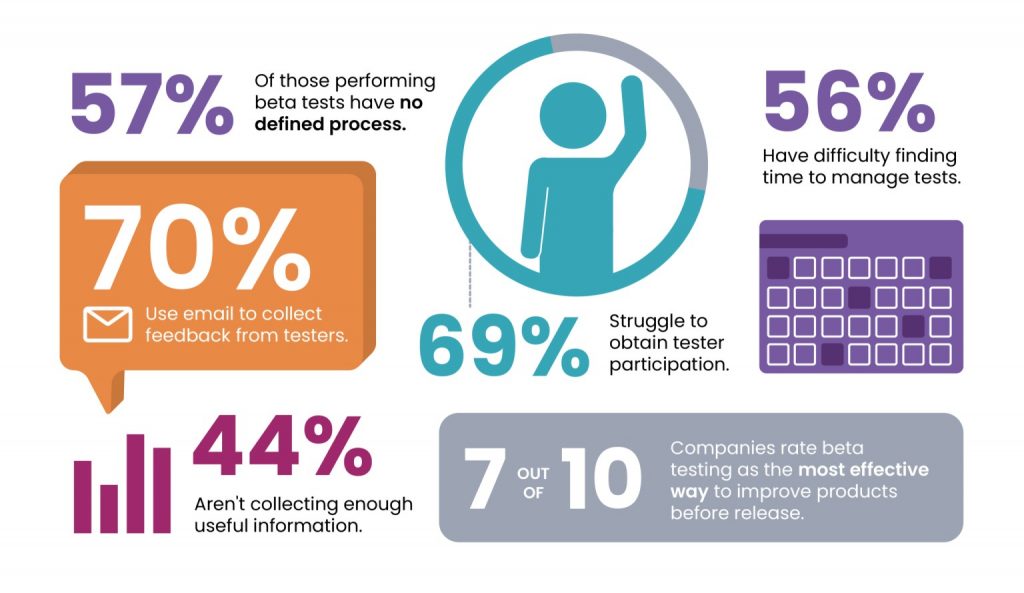
Let’s talk about Beta testing.
Beta testing is a vital process for product managers to refine their products before launch. In this blog post, our friends from Centercode, (Beta testing experts), explain the difference between good and bad beta testing, highlighting the importance of a proactive, thorough approach, valuing user feedback, and continuous improvement. Discover the secrets to successful beta testing and how it can significantly impact your product’s success.
TL; DR
- Good beta testing is thorough, proactive, and values user feedback.
- It involves comprehensive testing, stress tests, and usability trials.
- Bad beta testing is reactive, shallow, and overlooks critical issues.
- Beta testing is crucial for product success and should be approached as an opportunity for improvement.
Have you ever found yourself seated at your desk, just before you’re supposed to deliver a presentation, feeling the rush of adrenaline as you battle the waves of anxiety? Are you practicing your script in your mind, scrutinizing your visuals, and ensuring that everything is just right? Or are you walking away from your desk to go grab a coffee, hoping it all works out for the best?
As a product manager preparing to launch a new product, that’s your current predicament. The presentation is your product, and your expectant audience is your target market. It’s a rare skill to be able to deliver a flawless presentation with no rehearsal, which is why nearly everyone would find time to practice. So why would you try to launch a product without a chance to rehearse for the big day?
This product rehearsal, or beta test, is the final opportunity to rectify issues and refine your execution to help ensure that your product is launched successfully. It’s a safeguarding measure that guarantees your product, much like your presentation, resonates with the audience and earns the acclaim it merits. A thorough final run-through bolsters your confidence for when it’s time to step up to the mic, much like a successful beta test gives you peace of mind before your product launch.
Now, you may have heard tales about good beta tests, like Airbnb launching a beta that drove signups from 5,000 to 75,000 in just a single night or Slack’s Pre-Preview Release that kickstarted their success, and bad beta tests, like Apple Maps in 2012 or Windows Vista in 2006. Some of us may have even lived them. It’s a world where curiosity meets precision, where user feedback is gold, and constant improvement is the name of the game. But what really separates a good beta from a bad beta? What makes one soar and the other stumble?
Beta Testing by the Numbers
Picture your product after a successful beta test. It’s refined, robust, and ready for the world. It’s survived the trials, been molded by user feedback, and emerged stronger. That’s the power of good beta testing.

Despite its importance, companies struggle to run good beta tests:
- 7 out of 10 companies rate beta testing as the most effective way to improve products before release
- 57% of those performing beta tests have no defined process
- 70% of those running beta tests use email to collect feedback from testers
- 69% struggle to obtain tester participation, 56% have difficulty finding time to manage tests, and 44% aren’t collecting enough useful information
- The goal is to run a good beta test. And you know what? We’ve got just the resource to get you there.
Introducing Centercode’s new guide, The Ultimate Guide to Beta Testing. This comprehensive resource is designed to empower you, the product manager, with the process and fundamentals of beta testing. It’s a roadmap to maximizing your product launch with a great beta test, curated from the wisdom of industry veterans and cutting-edge strategies.
Let’s uncover the secrets that separate the good from the bad. Whether you’re a seasoned pro or just starting out, this is a journey we’re all on together. And with The Ultimate Guide to Beta Testing in your arsenal, you’re already one step ahead.
Good Beta/Bad Beta
Good beta testing is a process steeped in curiosity and precision. It rigorously interrogates every feature, leaving no stone unturned and no scenario untested. It isn’t satisfied with just a casual walkthrough of features. It dives deep, exploring the product’s capabilities, probing its limits, and testing its resilience in a range of situations. Bad beta testing, by contrast, stays shallow, glosses over details, and often misses critical issues.
Good beta testing is an active pursuit. It’s a process that seeks out potential problems before paying customers can encounter them. It uses a comprehensive, rigorous approach, employing stress tests, usability trials, and functionality checks to ensure that the product is ready to take on the world. Bad beta testing, however, is a reactive process, sitting back and waiting for issues to surface rather than proactively uncovering them.
Good beta testing values user feedback. It acknowledges that at the heart of every product is a user whose opinion is gold. It looks at user feedback as a guiding beacon, helping to steer the course of product improvements and fine-tuning. Bad beta testing overlooks this essential input, missing out on the opportunity to learn from the user’s perspective and improve the product accordingly.
Good beta testing is a never-ending process. It knows that there’s always room for improvement, always something more to learn, and always a way to make the product better. It’s not a checkbox on a list but an iterative process that loops in testing, learning, improving, and then testing again. Bad beta testing, on the other hand, views itself as a one-off event, not realizing the potential it has in ongoing testing and continuous improvement.
Good beta testing operates with a systematic and organized approach. It has a well-structured testing protocol, meticulous records, and a methodical process that treats each test as an important piece of the larger puzzle. Bad beta testing lacks this structured approach, failing to maintain comprehensive records and often allowing issues to go unnoticed or unresolved.
Remember, beta testing is more than a stage in product development; it’s an essential ingredient to your product’s success. It’s that final stretch of the journey before your product debuts on the grand stage. So, seize that opportunity. Use it to polish, perfect, and prepare your product to shine brightly when the spotlight hits.
Conclusion
Good beta testing is like your best friend, making sure you step out looking sharp and ready. It dives deep, asks the tough questions, and checks out every nook and cranny of your product. It’s always looking out for you, proactively spotting any problems so you can fix them before the big day.
Conversely, bad beta testing is like that unreliable “friend” who shows up late, skims over the details, and drops the ball when you need them most. And we all know how frustrating that can be, right?
But don’t worry, we’ve got your back! With our Guide to Beta Testing in your hands, you’re not just prepared—you’re supercharged! This guide is like your secret weapon, packed with tips and strategies from industry veterans, ready to help you ace your beta test.
So, as we wrap things up, remember this: Don’t treat beta testing like just another item on your to-do list. It’s an awesome opportunity to take your product from ‘good’ to ‘great’. It’s the final rehearsal before the big show, where you can tweak and polish your performance until it’s just right. And with good beta testing, you can ensure your product steals the spotlight on its grand debut.
That’s all from us. Now, here’s to you and to nailing your beta testing phase! Let’s go out there and make some amazing products, shall we?


